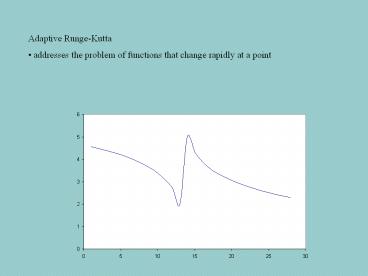Adaptive Runge-Kutta - PowerPoint PPT Presentation
1 / 24
Title:
Adaptive Runge-Kutta
Description:
Two approaches behind adaptive step size. look at difference between predictions with different step sizes but same order RK ... two different RK predictions of ... – PowerPoint PPT presentation
Number of Views:111
Avg rating:3.0/5.0
Title: Adaptive Runge-Kutta
1
- Adaptive Runge-Kutta
- addresses the problem of functions that change
rapidly at a point
2
- Would like to use small size steps in the area of
rapid change - normal size steps in area of
normal change - Two approaches behind adaptive step size
- look at difference between predictions with
different step sizes but same order RK - look at difference between predictions with
different order RK
3
Step-halving or adpartive Runge-Kutta let y1 be
single-step prediction let y2 be prediction using
two half steps
The correction is
fifth order accurate
4
Example
5
Integrate y from x0 to 2 using h2, and improve
using adaptive RK
Complete step results are
Half step results are
6
The correction is
The corrected value is
Compare to true value y(2)2.524369
7
Runge-Kutta-Fehlberg Uses two different RK
predictions of different order Special choice of
methods lets you use results from 4th order in
5th order RK - then combine them
8
Fourth order RK
Fifth order RK
9
Formula for ks
10
Example
Use h2, and the RKF method
11
The results are RK42.542811 RK52.554121 and
EaRK5-RK42.554121-2.5428110.01131 Now adjust
stepsize
12
If Ea is too small, increase step size If Ea is
too large, decrease step size
13
Stiffness stiff equation involves rapidly
changing parts and slowly changing parts
Solution is
14
(No Transcript)
15
Look at homogeneous part of equation
In general
Explicit Eulers method
16
Look at what happens to y over long time -
stability
If then y goes to infinity So for explicit
method to work - small h
17
Need to use implicit methods, rather than
explicit Implicit form of the Euler method
18
Implicit Euler is always stable - as i
increases y goes to 0
19
Example
Explict solution since a is 2000, let h0.0001
20
Stability limit is h0.0005 Try h0.0007
21
Try h0.001
22
h0.002
23
Implicit approach
24
h0.002































